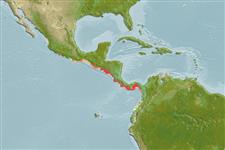Environment: milieu / climate zone / depth range / distribution range
Ecología
marino asociado a arrecife; rango de profundidad 10 - 25 m (Ref. 87125). Tropical
Eastern Central Pacific: Costa Rica , Panama and Mexico.
Tamaño / Peso / Age
Maturity: Lm ? range ? - ? cm
Max length : 3.0 cm SL macho / no sexado; (Ref. 11482)
Short description
Claves de identificación | Morfología | Morfometría
Espinas dorsales (total) : 6 - 7; Radios blandos dorsales (total) : 9; Espinas anales: 1; Radios blandos anales: 8. This species is distinguished by the following characters: fewer second dorsal and anal-fin rays than other species; a spotted head and body; distinctive head shape, when viewed dorsally, it is narrow and compressed anterior to the eyes, broadening posteriorly due to
the thick cheek muscles; males typically with a large mouth extending beyond the end
of the eye (Ref. 87125).
Occurs in reefs and rock outcrops surrounded by sand (Ref. 11482). Minimum depth from Ref. 58018.
Life cycle and mating behavior
Maturities | Reproducción | Spawnings | Egg(s) | Fecundities | Larva
Allen, G.R. and D.R. Robertson, 1994. Fishes of the tropical eastern Pacific. University of Hawaii Press, Honolulu. 332 p. (Ref. 11482)
IUCN Red List Status (Ref. 130435)
Threat to humans
Harmless
Human uses
Herramientas
Special reports
Download XML
Fuentes de Internet
Estimates based on models
Preferred temperature (Ref.
123201): 26.6 - 29.1, mean 28.2 °C (based on 129 cells).
Phylogenetic diversity index (Ref.
82804): PD
50 = 0.5000 [Uniqueness, from 0.5 = low to 2.0 = high].
Bayesian length-weight: a=0.00708 (0.00333 - 0.01504), b=3.09 (2.92 - 3.26), in cm total length, based on LWR estimates for this (Sub)family-body shape (Ref.
93245).
Nivel trófico (Ref.
69278): 3.1 ±0.3 se; based on size and trophs of closest relatives
Resiliencia (Ref.
120179): Alto, población duplicada en un tiempo mínimo inferior a 15 meses (Preliminary K or Fecundity.).
Fishing Vulnerability (Ref.
59153): Low vulnerability (10 of 100).
